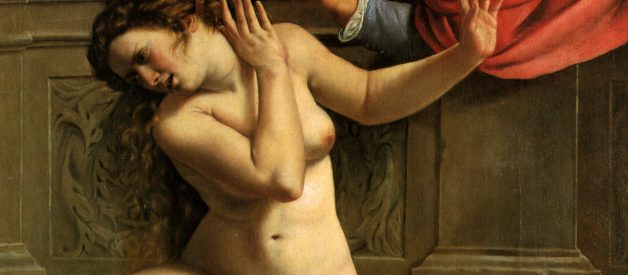A compelling and superbly composed work of art with a powerful narrative
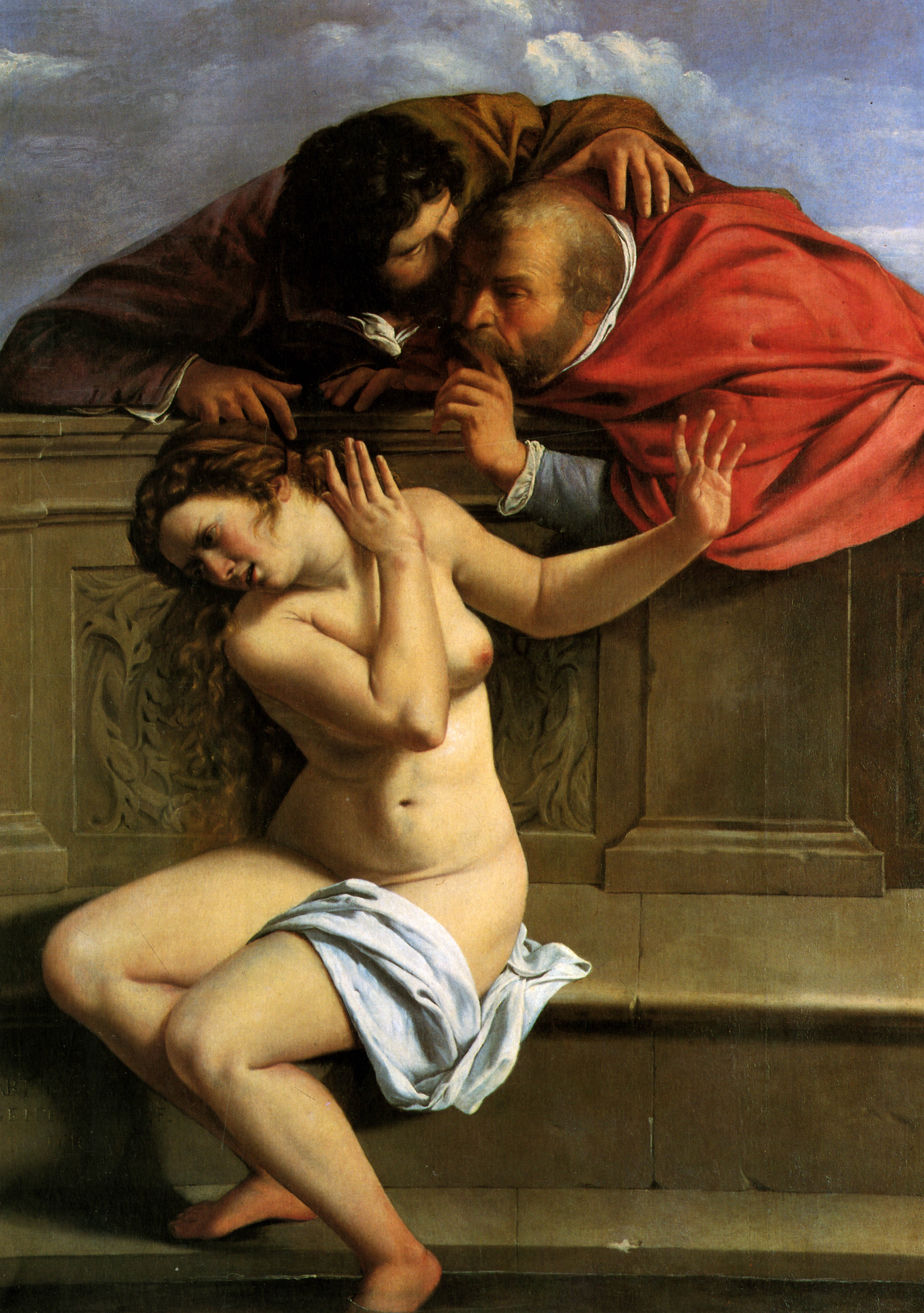 Susanna and the Elders (c. 1610) by Artemisia Gentileschi. Oil on canvas. Schloss Weienstein collection, Pommersfelden, Germany. Source Wikimedia Commons
Susanna and the Elders (c. 1610) by Artemisia Gentileschi. Oil on canvas. Schloss Weienstein collection, Pommersfelden, Germany. Source Wikimedia Commons
The painting shows two men leering over a wall, spying and conniving over a naked woman.
Their postures are threatening and lascivious. The way that the two figures combine into a single form, covers the full width of the painting, adopting the broad shape of a triangle ? a pyramid or a mountain, or something else heavy and stout ? giving the distinct impression of oppressing the woman seated beneath them.
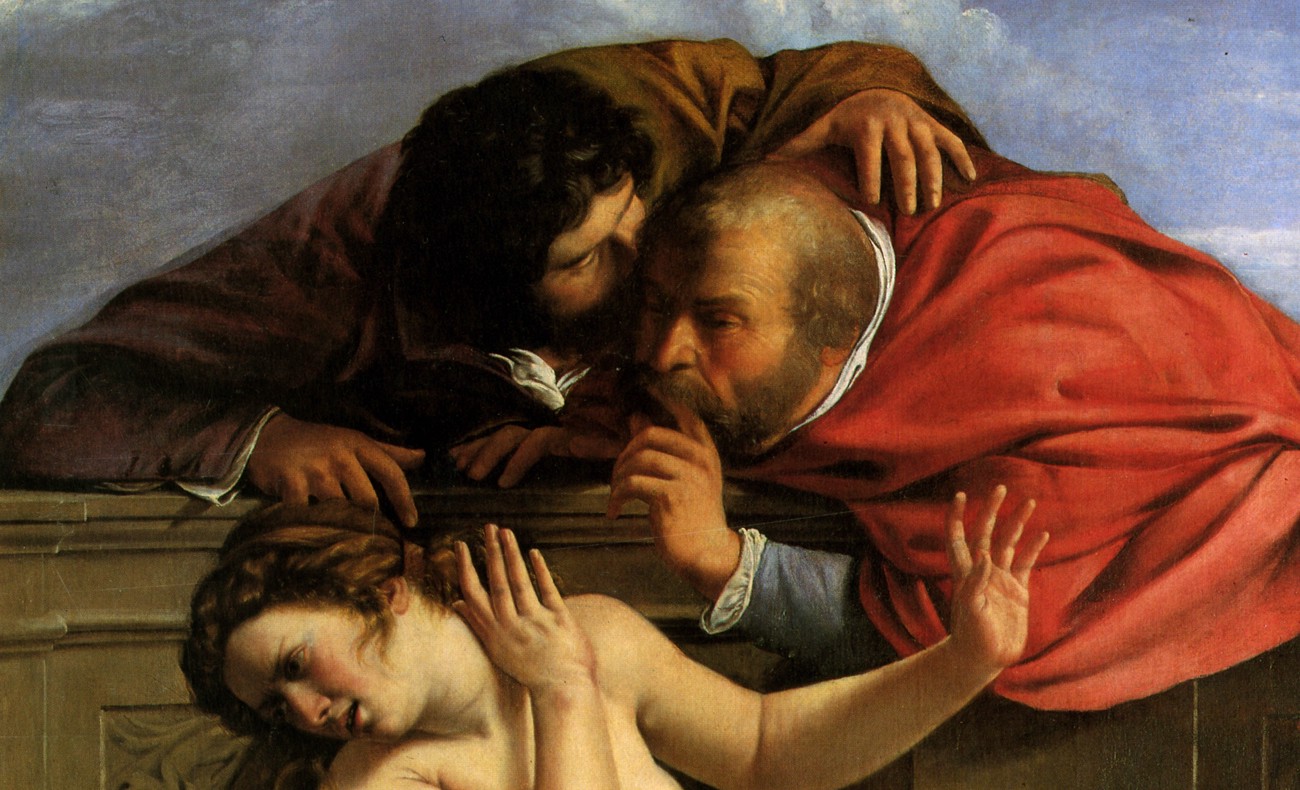 Detail of ?Susanna and the Elders? (c. 1610) by Artemisia Gentileschi. Oil on canvas. Schloss Weienstein collection, Pommersfelden, Germany. Source Wikimedia Commons
Detail of ?Susanna and the Elders? (c. 1610) by Artemisia Gentileschi. Oil on canvas. Schloss Weienstein collection, Pommersfelden, Germany. Source Wikimedia Commons
One of the men whispers into the other?s ear. He has his hand on the other?s shoulder. They are clearly in collusion as they loom over the bathing woman on the other side of the wall. The victim of their scheming is Susanna. She raises her hands in a defensive posture, illustrating without ambiguity that their attentions are unwanted and intrusive.
This scene is recognisable in the history of art as being about Susanna and the Elders, as told in the Book of Daniel.
The tale is set in Babylon during the Jewish exile and tells of Susanna taking a bath in her private garden. Two elders from the community secretly observe her and between them plot to seduce her.
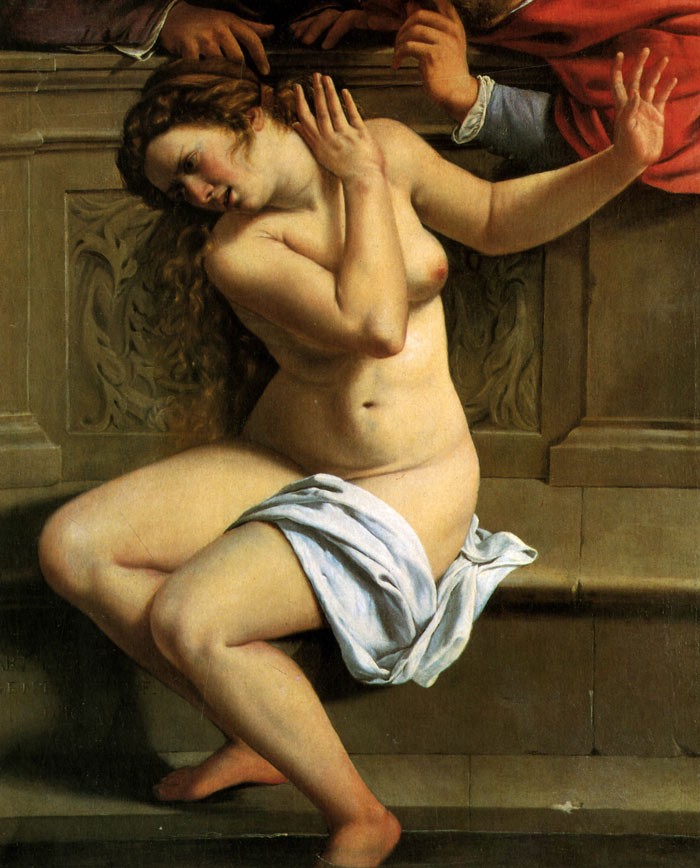 Detail of ?Susanna and the Elders? (c. 1610) by Artemisia Gentileschi. Oil on canvas. Schloss Weienstein collection, Pommersfelden, Germany. Source Wikimedia Commons
Detail of ?Susanna and the Elders? (c. 1610) by Artemisia Gentileschi. Oil on canvas. Schloss Weienstein collection, Pommersfelden, Germany. Source Wikimedia Commons
When Susanna sends her maids away and she is alone, the two lecherous men appear. They threaten the unsuspecting Susanna, telling her that unless she sleeps with them they will swear in public that they?d seen her in an act of adultery with a young man. Since Susanna was married, the accusation would bring great shame to her and her family, and worse, would carry the penalty of death if found guilty.
Susanna didn?t relent. Instead, she refused the elders and cried for help. The elders carried out their threat and Susanna was arrested. She was about to be put to death when Daniel ? a noble Jewish youth of Jerusalem ? interrupted and proceeded to cross-examine the two elders. He cleverly separated them and asked each to describe the tree under which they apparently saw Susanna commit her adultery. The two elders each described different trees; and so, with this conflicting evidence, Susanna?s innocence was proved.
Susanna was a fictional heroine whose symbolic appeal lay in the idea of innocent virtue eventually triumphing over evil. Her name in Hebrew means a lily, the symbol of purity. She became a popular subject in art because of these allegorical connotations, especially in Christian art, which made Susanna a symbol of the church ? with obvious anti-Jewish undertones.
Painted in around 1610, Artemisia Gentileschi was just 17 years old when she made the work. As the daughter of the Tuscan artist Orazio Gentileschi, historians have long wondered if the painting had a helping-hand from her father, as a way of explaining its extraordinary competency.
Undoubtedly, the time she spent in her father?s workshop provided an important apprenticeship for the young artist. However, looking across Artemisia?s entire painting career, she produced consistently high-quality works that prove her talents were well established even from such a young age. Moreover, the realism of her paintings compared to the more stylised technique of her father suggest that this work belonged to her entirely.
Artemisia?s version of Susanna and the Elders is especially effective in expressing the lascivious intent of the two elders and of the psychological response of Susanna. Many other artists who painted the same subject gave a more ambiguous reading of Susanna?s reaction ? one that perhaps enabled the (male) viewer to look upon the naked woman in the painting without the dubious sensation of participating in the elders? malign advances.
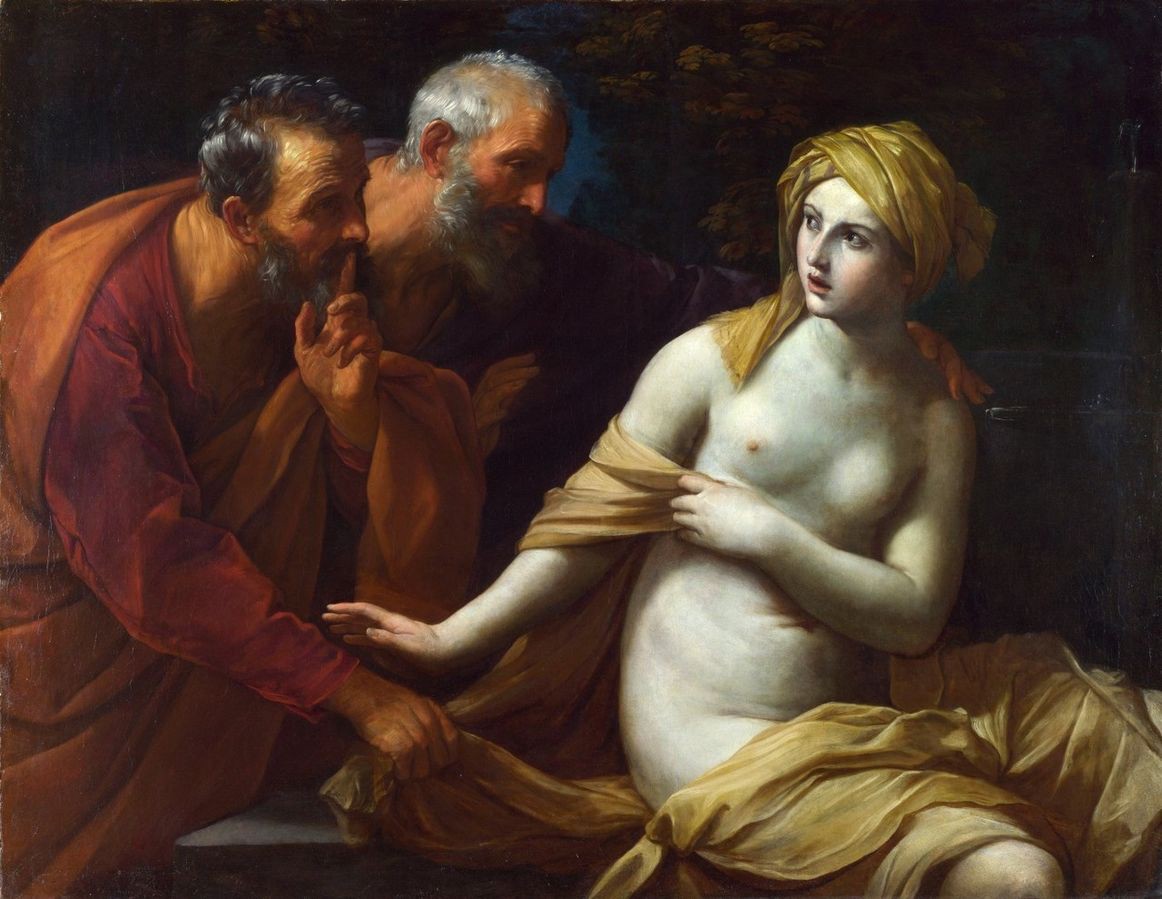 Susanna and the Elders (c. 1625) by Guido Reni. National Gallery, London (c. 1625). Image shown is a copy of Reni?s work, made by Francesco Ciseri. Source Wikimedia Commons
Susanna and the Elders (c. 1625) by Guido Reni. National Gallery, London (c. 1625). Image shown is a copy of Reni?s work, made by Francesco Ciseri. Source Wikimedia Commons
Guido Reni?s version, for instance, shows Susanna in more an equivocal pose, one of disquiet certainly, but also far less alarmed and fearful than the Gentileschi version.
It may be fair to say that Artemisia Gentileschi?s interpretation of the story gained from her being a woman, enabling her to depict a more vivid scene of sexual advance than her male counterparts were capable of imagining.
Much of Gentileschi?s reputation, particularly in more recent years, has been shaped by the rape she endured as a teenager in 1611, at the hands of another artist, Agostino Tassi. The case went to trial and detailed court records exist: it was a complicated situation, owing to the fact that Gentileschi and Tassi continued to have relations after the event, and also to the contemporary expectation of Gentileschi having been a virgin prior to the rape, without which the charges could not have been pressed. At the end of the trial, a disgraced Tassi was exiled from Rome, although no sentence was ever carried out.
Readings of Gentileschi?s art have been strongly influenced by these events, with many historians choosing to interpret her art as a proto-feminist response to her experiences. Indeed, many of Gentileschi?s paintings focus on strong female heroines from myth, allegory and the Bible. Two of her most well-known works are Judith Slaying Holofernes and Salome with the Head of Saint John the Baptist, both of which show female protagonists in barbarous acts against men.
It is difficult to discount the effect of Gentileschi?s experience of rape on the art she subsequently produced. Yet it may be more appropriate to place Gentileschi?s artwork in its wider historical context: as responding to a marketplace whose taste was for dramatic narratives of heroines from the Bible or classical sources.
 Susanna and the Elders (c. 1610) by Artemisia Gentileschi. Oil on canvas. Schloss Weienstein collection, Pommersfelden, Germany. Source Wikimedia Commons
Susanna and the Elders (c. 1610) by Artemisia Gentileschi. Oil on canvas. Schloss Weienstein collection, Pommersfelden, Germany. Source Wikimedia Commons
In the case of Susanna and the Elders, there is no need for such uncertainty anyway, since it was painted a year before Tassi?s crime.
What is also beyond question is the skill with which Gentileschi made the painting. The two elders, in their crouched, shadowy form, are expertly contrasted with the light-filled Susanna. Her twisted posture is especially effective in dramatising the very moment the old men appear to her.
Not only does the twisted posture show off the artist?s ability to represent the human figure in a complex yet realistic pose ? replete with perfectly painted shadows ? it also adds an extraordinary level emotional realism to the incident.
Susanna?s raised hands and splayed fingers, which are positioned in a self-defensive configuration, work in perfect concert with the position of her head, which is almost doubled-back in alarm.
A contemporary viewer of this work would almost certainly have been aware of the full story of Susanna. They would have known that her strength of character in the face of false accusations eventually resulted ? with Daniel?s help ? in her innocence being proved. The tension and apprehension depicted in Gentileschi?s painting would therefore have made the symbolism of innocent virtue triumphing over evil all the more gripping.

Would you like to get?
A free guide to the Essential Styles in Western Art History, plus updates and exclusive news about me and my writing? Download here.
Christopher P Jones is a writer and artist. He blogs about culture, art and life at his website.
